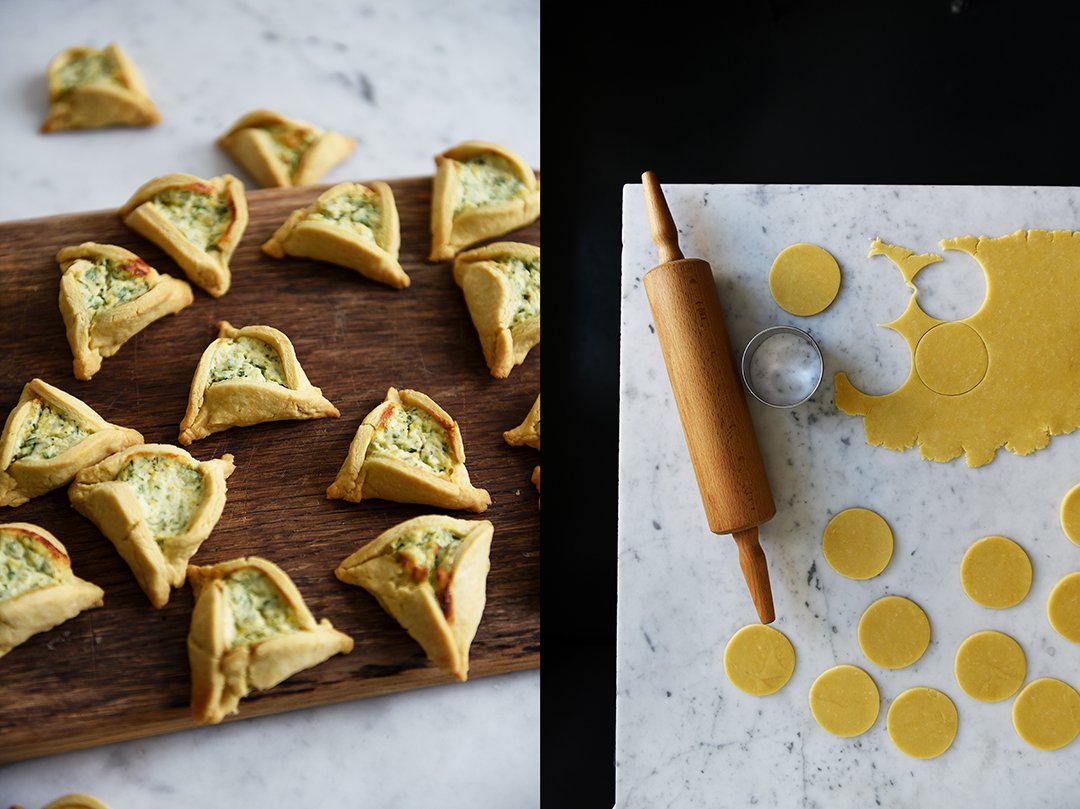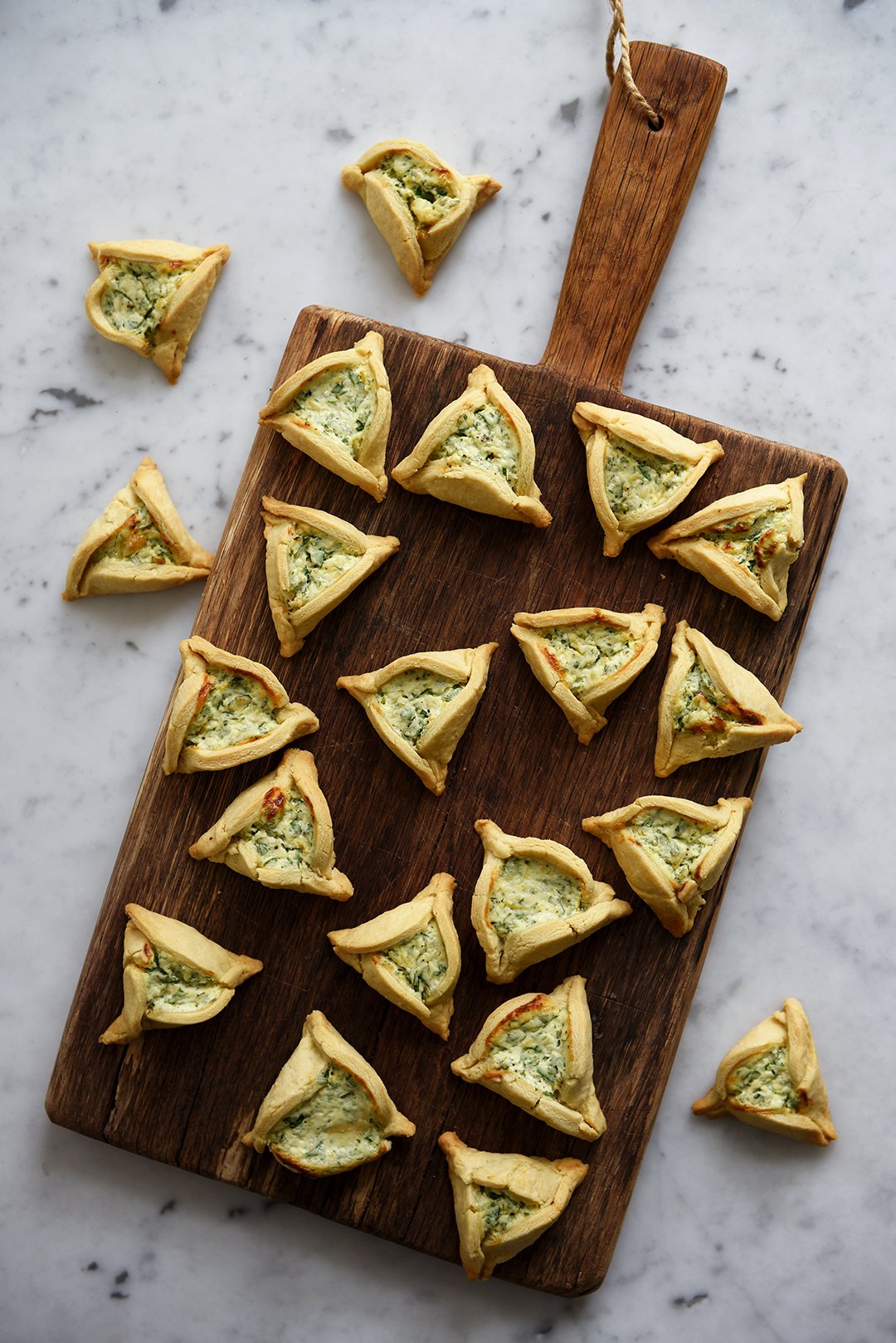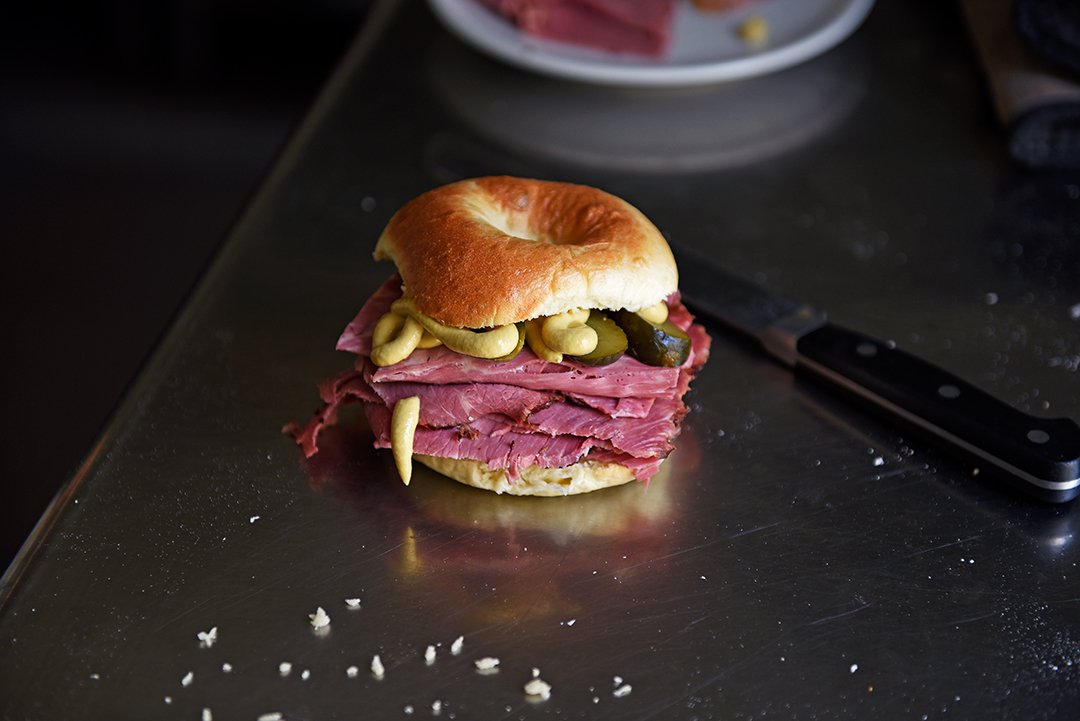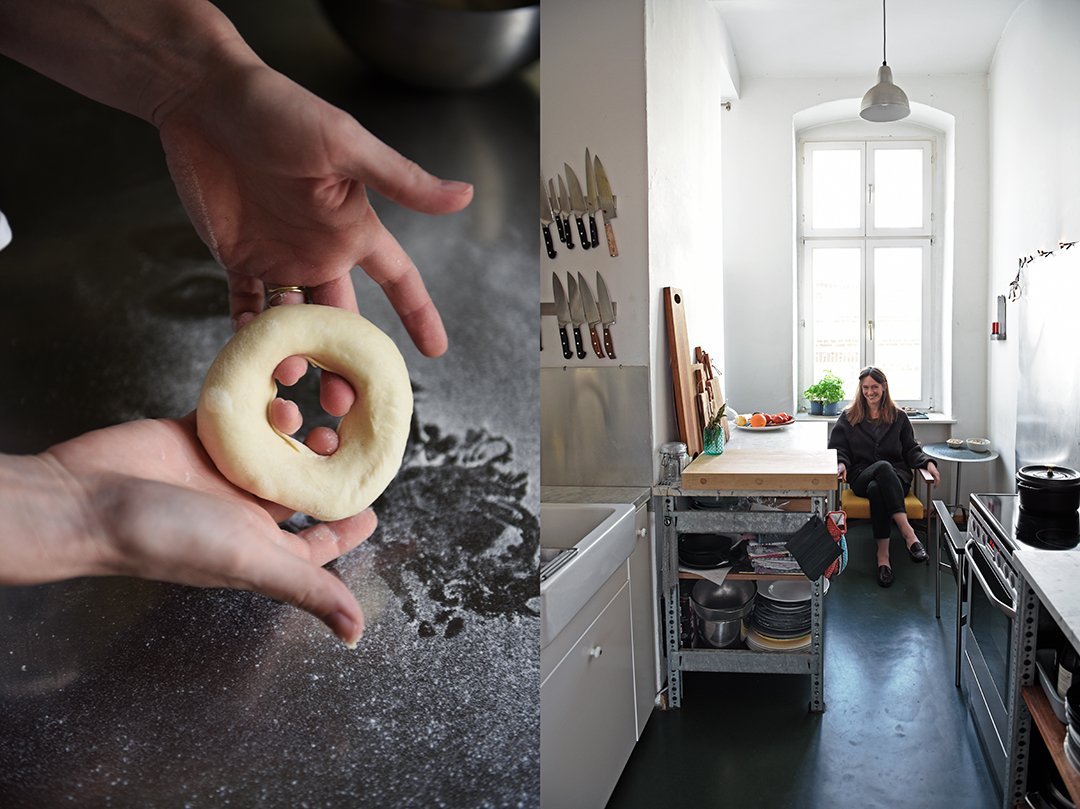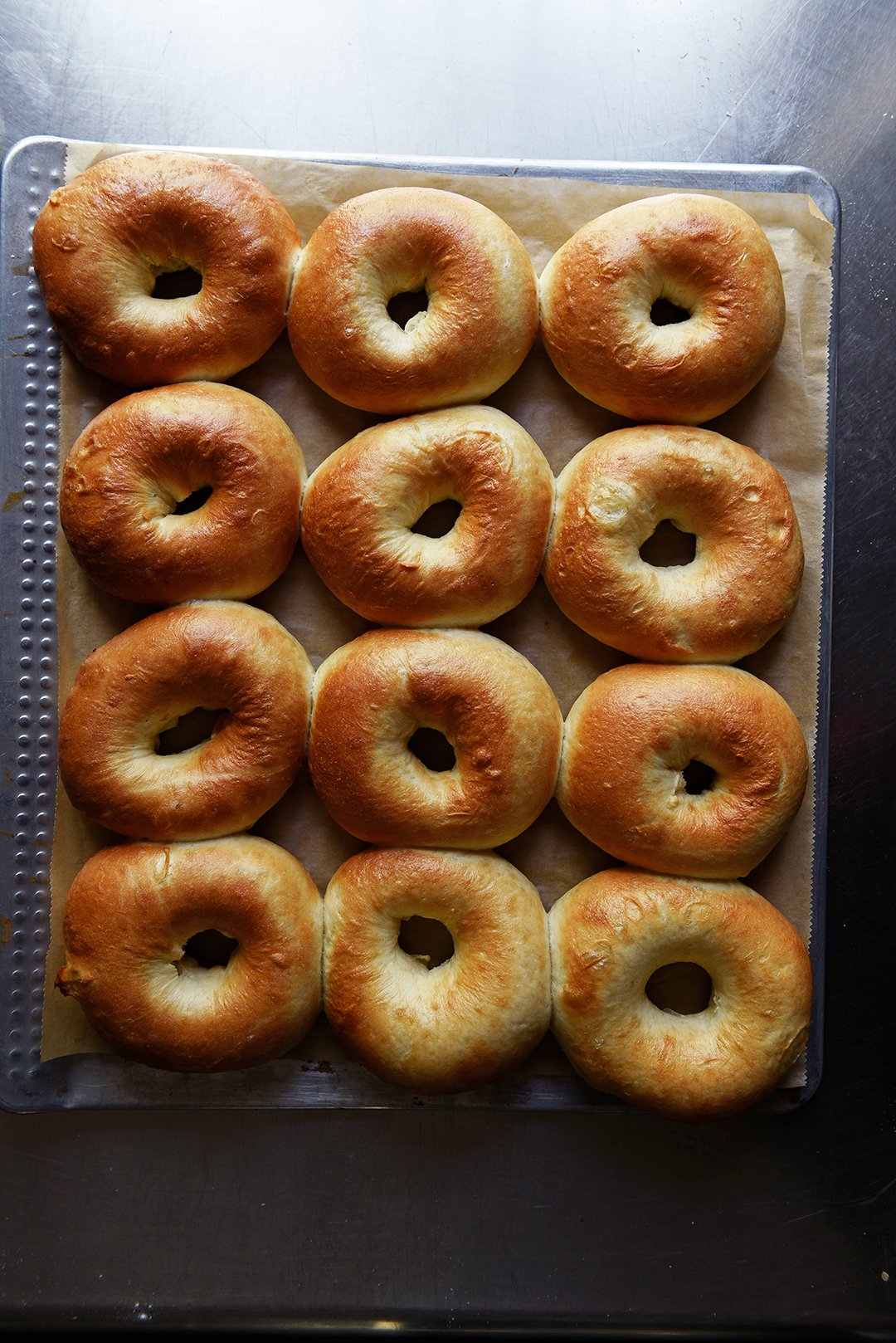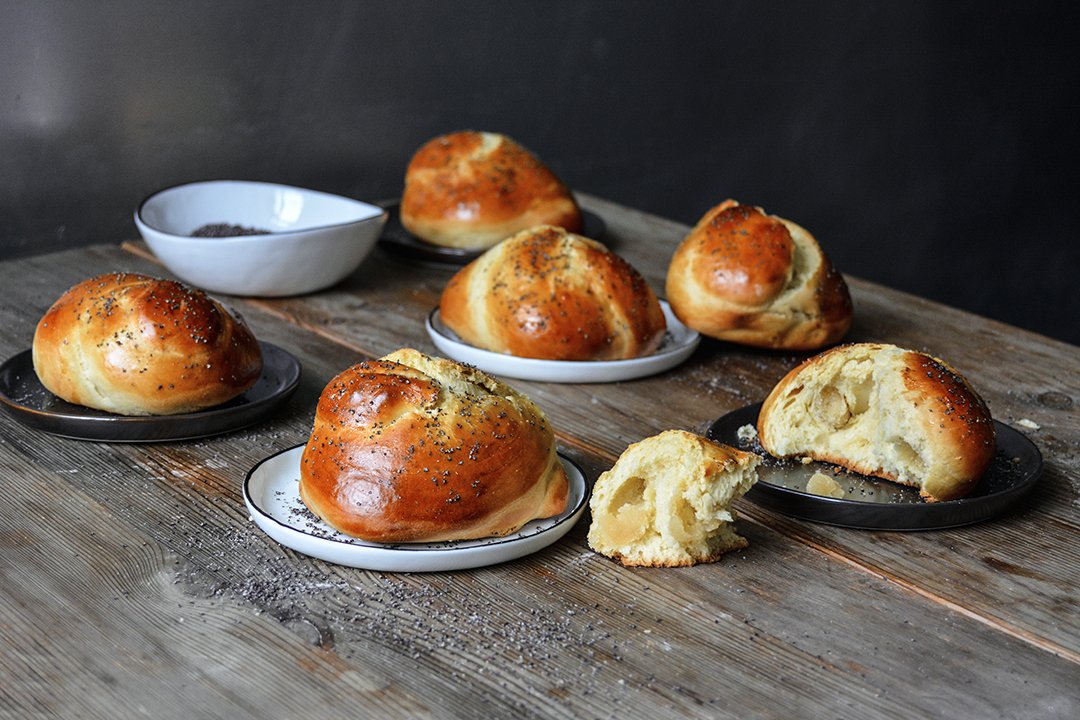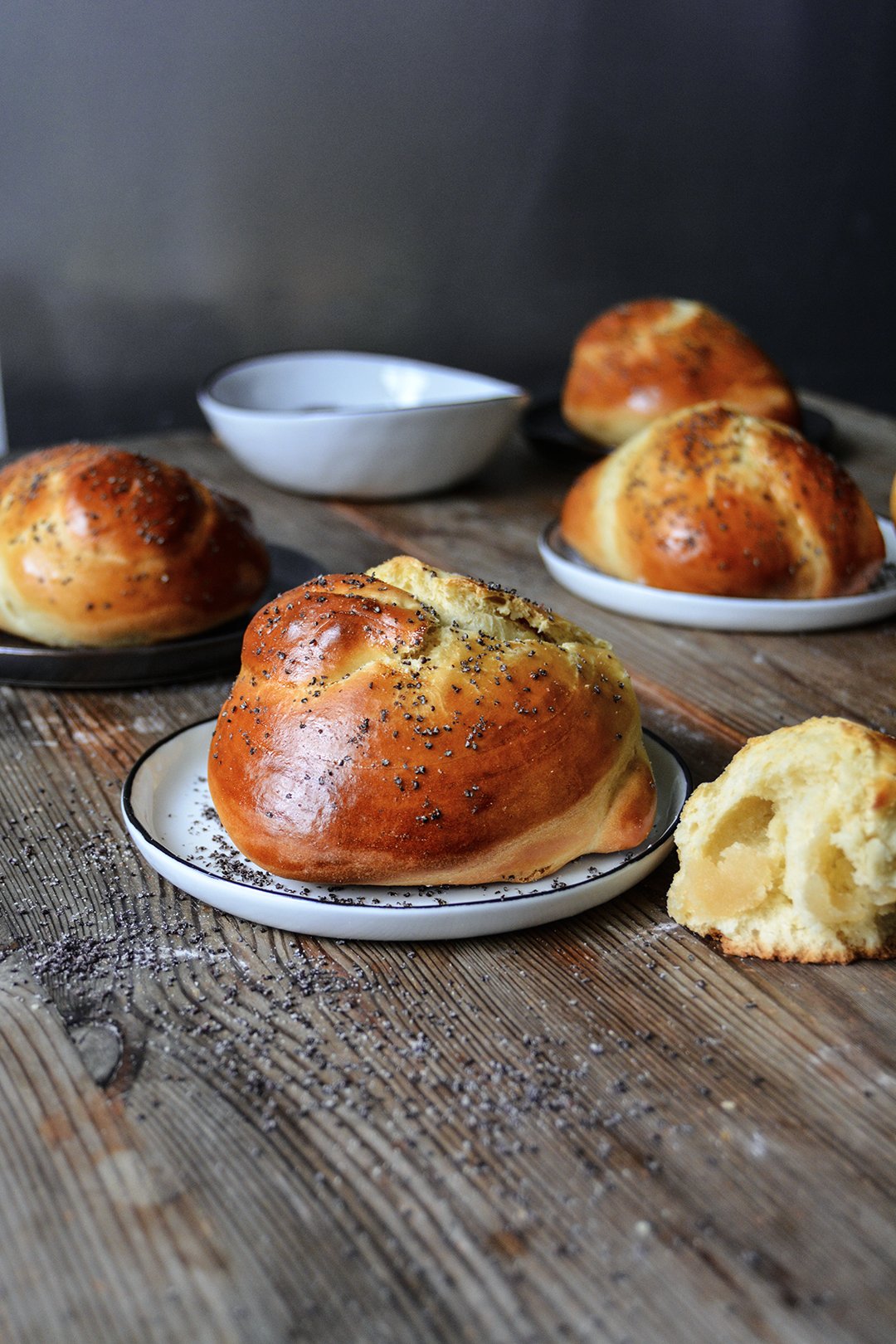Hamantashen with Lemon-Parsley Ricotta
Hamantashen are little pastry pockets, not more than a small bite, usually sweet and filled with poppy seeds, jam, or dried fruit. I turned them into a savory treat with a very lemony ricotta filling refined with lots of chopped parsley. It's a traditional Ashkenazi pastry, baked and shared during the Jewish holiday of Purim, starting this year on the evening of March 16th and ending 24 hours later. So why am I baking them? And why now?
My friend, the Berlin-based American baker Laurel Kratochvila of Fine Bagels spontaneously started Hamantashen for Ukraine, a show of worldwide bakery solidarity for the people of Ukraine. Profits of the sales are being donated to the Polish Humanitarian Action to help and support Ukrainian refugees at the Polish border. Laurel and her bakery friends will bake and sell hamantashen between now and March 17th, the 14th day of the Hebrew month of Adar. To find out where you can buy the charity pastries click here for the ever expanding list of participating bakeries all over the world.
Purim is celebrated to remember the saving of the Jewish people - thanks to queen Esther - from Haman, a vizier of the First Persian Empire who wanted to kill all Jews in the empire. Traditionally, food, drinks, and gifts are shared on this holiday, hamantashen are enjoyed together in the community, donations are given to the poor, and children and adults alike dress up in costumes. Maybe most importantly, these days there's often a reflection on modern day Hamans in the world. That's where this fundraiser comes in.
Laurel shared her recipe for sweet hamantashen with poppy seeds with me and I'll share my first attempt to bake hamantashen with you. Not sweet but packed with lemon-parsley ricotta.
Thank you, Laurel!
Hamantashen with Lemon-Parsley Ricotta
Makes 22 hamantashen
For the pastry
285g / 2 1/4 cups all-purpose flour
1 teaspoon fine sea salt
120g / 1/2 cup plus 1 teaspoon unsalted butter, cold
1 large egg
For the filling
125g / 4.5 ounces fresh ricotta, drained
1 large egg
30g / 1 ounce Parmesan, finely grated
1 small bunch fresh flat-leaf parsley, leaves only, finely chopped
1 scant tablespoon freshly grated lemon zest
1/4 to 1/2 teaspoon fine sea salt
Coarsely ground pepper
For the pastry, combine the flour and salt in the bowl of a stand mixer fitted with the paddle attachment. Add the butter and use a knife to cut it into the flour until there are just small pieces left. Quickly rub the butter into the flour with your fingers until combined. Add the egg and briefly mix with the paddle until crumbly. Form the dough into a thick disc, wrap it in plastic wrap, and chill in the fridge for 1 hour.
Preheat the oven to 180°C / 350°F (preferably convection setting). Line a baking sheet with parchment paper.
For the filling, whisk together the ricotta, egg, Parmesan, parsley, lemon zest, 1/4 teaspoon salt, and a generous amount of pepper in a medium bowl. Season to taste with additional salt.
On a work surface, place the dough between 2 sheets of plastic wrap and use a rolling pin to roll out until it’s about 3mm / 1/8 inch thick. Using a 7cm / 3 inch round cookie cutter, cut out circles, re-rolling any pastry scraps. Place 1 teaspoon of the filling in the middle of each circle. To shape, fold 3 sides inward to make a triangle, either overlapping or pinching where the edges meet. Transfer to a large platter and chill in the fridge for 10 minutes.
Transfer the hamantashen to the prepared baking sheet and bake for about 18 minutes or until the pastry is golden and just baked through. Let them cool for a few minutes and enjoy!
______________________________
Hamantashen with Poppy Seeds
by Laurel Kratochvila / Fine Bagels
Makes 40 hamantashen
For the pastry
440g / 3 1/3 cups all-purpose flour
240g / 1 cup plus 1 teaspoon unsalted butter, cold, cut into cubes
130g / 1 cup plus 1 tablespoon finely ground almonds
120g / 1 cup confectioners sugar
1/4 teaspoon fine sea salt
2 large egg, beaten
1 teaspoon vanilla extract
For the filling
150g / 1 1/2 cups ground poppy seeds
75g / 1/3 cup plus 1 tablespoon granulated sugar
210ml / 3/4 cup plus 3 tablespoons whole milk
2 teaspoons unsalted butter
1/2 lemon, juice only
2 tablespoons honey
For the pastry, in the bowl of a stand mixer fitted with the paddle attachment, mix the flour and butter on low speed until sandy in texture, no bits of butter remaining. Add the ground almonds and confectioners sugar and mix until well combined. Add the salt, eggs, and vanilla and mix on low until the dough has just come together and no dry bits remain. Press the dough into a thick disc, wrap it in plastic wrap, and chill in the fridge for 2 hours or up to 48 hours.
For the filling, in a heavy, medium saucepan, bring the poppy seeds, sugar, milk, butter, and lemon juice to a gentle boil over medium heat. Reduce the heat to low and simmer until thickened. Remove from the heat, stir in the honey, and let cool completely before using. Covered airtight, you can refrigerate it for up to 1 week.
Preheat the oven to 170°C / 340°F. Line a baking sheet with parchment paper.
To use the chilled pastry, you must break it: Fold it in half and roll it out once. It will crack. Fold the dough back up and roll out a second time. Now it's ready.
On a work surface, place the dough between 2 sheets of plastic wrap and use a rolling pin to roll out until it’s about 3mm / 1/8 inch thick. Using a 7cm / 3 inch round cookie cutter, cut out circles, re-rolling any pastry scraps. Place 1 teaspoon of the filling in the middle of each circle. To shape, fold 3 sides inward to make a triangle, either overlapping or pinching where the edges meet. Transfer to a large platter and chill in the fridge for 20 minutes.
Transfer the hamantashen to the prepared baking sheet and bake for about 15 minutes or until the pastry is golden and just baked through. Let them cool for a few minutes and enjoy!
Meet In Your Kitchen | Berlin's Best Bagel Baker
This post is part of my Meet in My Kitchen podcast: How did we get to where we are in life & what does food have to do with it
“Food is making other people love me, it’s very manipulative. That’s how I use food!”- Laurel Kratochvila
For months, a friend who knows how much I love to talk, question, and discuss has been bugging me to start a podcast. So thanks to my friend Anne's persistence, here's my new baby: the Meet in My Kitchen podcast!
For this new series, I invite guests to my kitchen in Berlin, people whose journey in life I find inspiring, to find out how they got to where they are in life, to learn about the struggles they had to overcome, how the highs and lows shaped them - and what food has to do with it. My guests are chefs and home cooks, farmers, bakers, and artists, they are all curious adventurers who share a deep zest for food and life. I also visit each guest in her or his kitchen, or restaurant, or bakery, where they share a recipe with me, which you can find in my blog's Meet in Your Kitchen series.
You can listen to the Meet in My Kitchen podcast on all common podcast platforms, there will be English and German episodes.
Many years ago, I discovered a small book shop in my Berlin neighborhood, specializing in English literature. It was a quiet, dark space with wooden floors and vintage furniture, and a little counter filled with the loveliest loaf cakes. I came back almost every week, mainly for the sweets, and soon found out that the shop was run by an American/ Czech couple: Laurel from Boston, responsible for baking, and her husband Roman Kratochvila from Prague, taking care of the books.
They left my neighborhood too soon, creating a void that could never be filled, but they re-opened a much brighter and bigger spot just as charming. This became the famous Shakespeare and Sons / Fine Bagels on Berlin's lively Warschauer Strasse, praised and loved for Jewish baking classics - and good books. Laurel's bagels, challah knots, and rugelach are known across town and get me to hop on my bicycle regularly to enjoy her sweet and savory treats.
I'm intrigued by Laurel's passion and dedication, and her irresistible smile that wipes away all sorrows. She started as a home baker and then deepened her knowledge and education in French bakeries, but she still has this relaxed aura of 'a friend who's just baking in her kitchen.' Laurel treats her dough like a baby, she knows it well, watches and works it precisely, until it unfolds its true beauty.
For this podcast episode, Laurel shared her recipe for Brick Lane bagels with me (named after London's famous Brick Lane Beigel bakery). She calls it a mix of a New York and a Montreal bagel. Quick to prepare, a little chewy, and perfect for a luscious sandwich filled with salt beef, mustard, and gherkins, you can now satisfy your bagel cravings in your own kitchen any time.
The podcast episode with Laurel Kratochvila is in English. You can listen to the Meet in My Kitchen podcast on all common podcast platforms; there are English and German episodes. You can find all the blog posts about my podcast episodes including my guests' recipes here on the blog under Meet in Your Kitchen.
Listen to the podcast episode with Laurel on:
Spotify / Apple / Deezer/ Podimo
On Instagram you can follow the podcast @meetinmykitchenpodcast!
Laurel’s Brick Lane Bagels
Makes 12 bagels
1 kg / 7 2/3 cups bread flour or all purpose flour (type 550 in Germany, T55 in France)
50 g / 1/4 cup white sugar
1 envelope (7 g / 1/4 ounce) fast-acting yeast or 18 g / 2/3 ounce fresh yeast
10 g / 2 teaspoons fine sea salt
420 ml / 1 3/4 cups lukewarm water
1 large egg
15 ml / 1 tablespoon vegetable oil
sugar for boiling the bagels
sesame and / or poppy seeds for the topping
For the sandwich
salt beef, very thinly sliced
mustard
gherkins, sliced
Preheat the oven to 230°C / 450°F (or the highest temperature setting of your oven). Line 2 baking sheets with parchment paper.
In a large bowl, whisk together the flour, sugar, yeast, and salt then, in a medium bowl, whisk together the water, egg, and vegetable oil, and add to the flour mixture. Mix into a shaggy mass by hand or with a wooden spoon. Then knead by hand for 10 minutes or until the dough is smooth. Avoid adding more flour as you knead it. Form the dough into a ball and set into a lightly oiled bowl. Cover with plastic wrap or a damp cloth and let rise for 30 minutes in a warm environment. Meanwhile, set a large pot of water on the stove to boil.
Divide the dough into 12 pieces and roll them into tight balls, cover with plastic wrap. After ten minutes, press a hole through the middle of each ball of dough with your thumb or elbow (see pictures below). Stretch out the bagel a bit and place on a lightly floured work surface.
Add a couple spoonfuls of sugar to the boiling water. In batches (2-3 bagels at a time), boil the bagels for 30 seconds to 1 minute, flipping them once. Don’t overdo it! Using a slotted spoon or spatula, remove the bagels from the water and transfer to the prepared baking sheets. Top with seeds of your choice. Bake the bagels for about 10 minutes or until golden.
To make the sandwich, cut a bagel in half, stuff it generously with thinly sliced salt beef, drizzle with mustard, top it off with a few slices of gherkins, and close the bagel with its top.
Enjoy!
Laurel Kratochvila's Marzipan-Ribboned Challah Knots
I don't even remember how it started. It must have been a few years ago when my man and I welcomed a new tradition: coffee dates. Whenever we find time to take an hour off work, we squeeze in a dark Italian espresso or a creamy cappuccino, happily enjoyed in one of the countless cafés in our area. And on Saturdays - overly excited by the luxury of having plenty of free time - we often stretch it into a lunch-teatime-aperitif date. Just the two of us, chatting about whatever's on our mind, no plans or duties, just lingering until we decide to move on.
On one of these dates, we went to the new Shakespeare and Sons / Fine Bagels. The book shop and bakery used to be close to where we live, but the two owners, Roman and Laurel, had to transfer their cafe and literature business to a new location. That was the first time I tried Laurel's absolutely outstanding chocolate rugelach, which blew my mind and made me want (or rather have to) meet the woman behind this treat.
When we met, our chat led to a Meet In Your Kitchen feature (including my beloved rugelach recipe), but most importantly, I found a woman who's a great inspiration. Laurel loves food, she's obsessed with baking, she's gifted with an unbelievable amount of energy, and when you talk to her, you can see her beautiful soul. She's honest, critical, and crazy enough to overcome her fears and jump into the next adventure. Nosh Berlin is her new baby, a Jewish food week, starting March 17th. It'll be a week packed with talks, feasts, and Jewish food. I already booked my tickets for two events, Molly Yeh is coming on the 22nd and I didn't dare to miss The Gefilte Ball on Thursday. You can find the program of all the events below or on the Nosh Berlin website.
When I met Laurel for a coffee a couple weeks ago to hear everything about her exciting events, I nibbled on my obligatory rugelach and she chose a new creation, her current obsession: a marzipan-ribboned challah knot. She looked so happy whenever she took a bite of her yeast bun that I thought, I need this recipe. Laurel is a nice person who loves to share, I didn't even need to beg her. And here it is, fluffy yeast buns, not too sweet, generously filled with marzipan, and so good, that I ate five of them in a day and a half. Laurel only uses egg yolks, melted butter, and water in this recipe. She uses bread flour, however I replaced it with white spelt flour that comes to use in all of my baking recipes. I had to add a little more flour and I think that a bit more wouldn't have harmed the texture, but helped the knots to keep their shape a bit better and avoided cracks on the surface. As you can see in the pictures, my knots turned into roundish buns in the oven. I didn't mind, challah knot or bun, I love Laurel's latest creation.
Nosh Food Festival
- Friday, March 17th - Kiddush: North African Jewish dinner by Yuval Belhans and Mayaan Meir
- Sunday, March 19th - The Nosh Market at Markthalle Neun Oma and Bella: Movie and a Nosh at Babylon Berlin
- Monday, March 20th - The JCC Krakow presents Jewish Polish Food History. Talk and a tasting
- Tuesday, March 21st - What Jew Wanna Eat? Amy Kritzer, visiting chef from Austin, Texas, presents creative Passover cooking.
- Wednesday, March 22nd - Molly Yeh and Luisa Weiss: Cookbooks, Blogs, and Jewish Baking
- Thursday, March 23rd - Nosh Berlin and Shtetl Neukölln present The Gefilte Ball. Talk and demo with Jeffrey Yoskowitz of The Gefilte Manifesto followed by a klezmer ball.
- Friday, March 24th: Night of Shabbat Supper Clubs
There will also be a couple talks on various Jewish food topics at the Fraenkelufer Synagogue and a showing of Cafe Nagler with a presentation on pre-war Jewish cafe and restaurant life. Additionally, there are Jewish cookery classes all week at Goldhahn and Sampson in Charlottenburg.
Marzipan-Ribboned Challah Knots
If you decide to double the recipe, use only 9 egg yolks, which is Laurel's original recipe.
Makes 7 challah knots
organic egg yolks 5, plus 1 egg white, beaten, for the glaze
butter, melted and cooled, 40g / 3 tablespoons
water 175ml /3/4 cup
bread flour (or white spelt or unbleached wheat flour), 410-480g (3 cups plus 2 tablespoons - 3 2/3 cups), plus more if the dough is too sticky
granulated sugar 100g / 1/2 cup
fast-acting yeast 1 1/4 teaspoons
fine sea salt 1 teaspoon
marzipan, cut into 7 pieces, 150g / 5 ounces
poppy seeds 1 tablespoon, for the topping
In a medium bowl, whisk the egg yolks and butter. Add water and whisk until well combined.
In the large bowl of a stand mixer, whisk together the flour (410g / 3 cups plus 2 tablespoons), sugar, yeast, and salt. Add the liquid mixture and, using the paddle attachment, mix for about 1 minute until combined. Replace the paddle attachment with the dough hook and knead for about 10 minutes. I use setting ‘4’ on my KitchenAid. Add more flour if the dough is too sticky, but mind that it should stay soft. If you prepare the dough by hand, keep kneading an extra few minutes. Transfer to a clean, oiled bowl, cover with a kitchen towel and let rise in a warm place, or preferably in a 35°C / 100°F warm oven (conventional setting), for about 60-70 minutes or until spongy. When you poke the dough, the indentation of your finger shouldn't spring back.
Punch the dough down and then turn out onto a floured work surface. Give it a quick knead to form it back into a ball and then cut 7 equal pieces. Cover with a tea towel and let rest for about 15 minutes.
Line a baking sheet with parchment paper.
Once rested, roll the dough into logs (about 25cm / 10" long) and then gently press flat. Lay a strip of marzipan lengthwise down the middle of the flattened log (using my hands, I first rolled each piece of marzipan into a long log) and then fold the log lengthwise in half, so you have a marzipan-filled log (see first picture). To fold the log into a knot, make an overlapping circle and then wrap the upper end under and then up through the middle (see first picture).
Preheat the oven to 175°C / 350°F (convection setting).
Once all 7 knots are folded, transfer to the lined baking sheet and brush with the beaten egg white. Laurel puts a little simple syrup in the egg glaze to add some extra sweetness, I left mine plain. Let them rise for about 30 minutes or until puffy. Glaze the challah knots with egg whash a second time then sprinkle with poppy seeds.
Bake for about 20 minutes or until the challah knots are golden brown and shiny.
meet in your kitchen| Shakespeare & Sons, Berlin and Laurel's Chocolate Rugelach
"They both slow you down. They’re both transportive. They both smell good. They can both be enjoyed at the same time" - Laurel's words, when I asked her what she likes about the connection of food and books.
I've enjoyed sweet treats made by Laurel's hands for many years, but it took a while for us to meet personally. Together with her business partner Roman, the young woman from Boston runs Berlin's popular Shakespeare & Sons and Fine Bagels - a heavenly place for English books, bagels, cookies, rugelach, and cakes - all in one store! Originally, they started their Berlin business in a cozy space in Prenzlauer Berg that was, conveniently, quite close to where I live. But two years ago they had to move and I lost my dear store. A recent coffee date at their gorgeous new store in Friedrichshain brought back memories and awoke the idea to meet the stranger behind all these amazing sweet goods. It was actually a chocolate rugelach - possibly the best rugelach I ever ate - that made me get in touch with Laurel that same day. Her rugelach is gooey, chocolatey, sweet and juicy, it's so good that you basically have to order one after the other. When we met later, Laurel told me that her dear friend Sanam used to say that every rugelach sticks to your hips for seven years. If something tastes so good, I don't care about my hips, it's worth every pound!
Laurel is a self-taught baker with a weak spot for anything baked and sweet, a trait of her food loving family. Especially the women are quite gifted and know how to impress the hungry crowds at their kitchen tables with homemade cookies, cakes, and breads. Luckily, for generations, this passion has been passed on to the young ones.
Although she calls herself a shy bird who prefers to stay behind the scenes, when I saw her roll out the puffy yeast dough, dishing out stories about Israeli and American rugelach, I didn't believe it at all. Laurel sounds like a pro who must have a cooking show one day. I enjoyed watching her spread the dark chocolate filling lusciously over the orange flavoured dough so much, that I almost forgot how hungry I was. Luckily, it only took 15 minutes and she pulled out the most fragrant warm rolls in front of my camera - and then they went straight into my mouth.
Shakespeare and Sons also have the English Eat In My Kitchen book on their shelves!
Laurel's Chocolate Rugelach
For the dough
7 cups / 910g bread flour
2/3 cup / 130g granulated sugar
4 1/2 teaspoons instant yeast
2 teaspoons salt
1 cup / 225g butter
1 1/3 cups / 315ml milk
1 tablespoon vanilla extract
4 eggs
zest of 1 orange
For the filling
3 cups / 600g of sugar (this can be substituted for demerara or even muscavado for a stronger flavor)
2 1/4 cups / 270g unsweetened cocoa powder
3 tablespoons ground cinnamon
1 3/4 cups / 415g butter
For the egg wash
2 eggs, lightly beaten
In a bowl, whisk together flour, sugar and yeast. When that is mixed in, add salt and whisk again. In a saucepan, melt butter on low heat and then remove from heat. Add milk and whisk. Add vanilla and eggs and whisk. Pour liquid mixture into the flour mixture. If using a mixer, mix until incorporated with the paddle attachment, then switch to a dough hook. Knead with the dough hook for 5 minutes. If mixing by hand, mix well with a wooden spoon and then turn out onto a floured surface and kneed well for about 7 minutes. It's a very stick dough however, so it's best to use a machine. Put the kneaded dough into a well-greased bowl, cover with a wet cloth or plastic wrap, and let rise for about an hour or until your fingerprint in the dough doesn't spring back.
Preheat the oven to 175°C / 350°F. Line 2 baking sheets with parchment paper.
While your dough is rising, make the filling. Mix sugar, cocoa, and cinnamon. Melt butter and pour on while hot. Mix well. Set aside to cool. You can cool it faster in a refrigerator, but be careful not to let it sit in the fridge for too long. It will turn into a solid block.
Turn out your dough onto a floured surface and cut it into 3-5 balls, depending on how large you want your rugelach. There's no need to punch down the risen dough, as the rolling will do that for you. Roll out one of your dough balls into a perfect circle about 1/2cm / 1/4" thick. Spread your filling evenly and thinly across the dough, being careful not to tear the gentle dough. Use a pizza cutter to trim the edges and to divide the dough circle into about 12 triangles, like pizza slices. Now starting from the outside of the circle, roll up your rugelach so they look like little croissants. Place on a baking sheet.
When you've done this for all of your dough, brush your rugelach with an egg wash and bake for about 15 minutes. When you take them out of the oven, drizzle with simple syrup. Oh damn, now you get to eat them.
This recipe also freezes beautifully. I usually bake up as many as I want and put the rest of the unbaked rugelach in the freezer to take out and bake as I need them. (Think about the possibilities here. Seriously. Lazy winter weekend mornings in bed and then...poof...15 minutes later you've got gooey hot rugelach in your kitchen? This is a maximum pleasure recipe so it's a wise move to keep them on hand). Just give them a few minutes to thaw before you throw them in the oven.
How does an ex-physicist decide to start a bagel shop? When did you come up with the idea? Did this idea grow over years or was it a spontaneous decision?
Ha, I don’t know if I’d call myself an ex-physicist. I’d say I got the physics degree and ran. The bagel shop happened out of pure, selfish necessity. I found myself living in the first-class bagel desert of Berlin and, frankly, I was hungry. I tried to assimilate, I swear. Ate broetchens, croissants, muesli...you name it. What can I say? They weren’t doing it for me like a bagel and cream cheese does. I’ve always been a home baker, wasn’t particularly focused on anything else at that point in my life, and it just struck me as something to do. So pretty spontaneous.
At your peak, you baked 350 bagels every day on your own before you put your team together. You offer 25 different bagels at your shop, sweet and savoury. What fascinates you about this popular bun with a hole in the middle?
The bagel is a creature of the diaspora. At this point, it’s as much American as it is Polish-Jewish. It’s spent the last hundred years moving out of the basement-level New York bakeries, getting softer and bigger, and landing on breakfast plates the world over. At the same time, bagels are no longer created with the same reference point or even a nod to their history, and I think it’s important to maintain standards. What I like about a proper bagel is the deliberate chewiness and the impractical hole. The hole serves only to gush cream cheese and soil your clothes. And yet it’s got to be there. More surface area for the flavorful skin. So it’s not an easy food. But it’s such a good food.
Both of us share a passion for rugelach, can you tell us a bit about the difference between American style rugelach and the traditional recipes rooted in Israel?
Ok, so the kind of rugelach I’m familiar with from back home (Boston) are more of a gently flaky cookie made with a cream cheese or sour cream dough and a filling of jam, chopped nuts, raisins, and cinnamon sugar. The dough is a royal pain to work with, but worth it. Meanwhile the rugelach you’d find in Israel are generally from a yeasted dough and reach the level of chocolate-y gooeyness that solicits involuntarily obscene vocals from those eating them. Or maybe that’s just me. This is disloyal to my upbringing, but I’m just going to say it: there is nothing better than an Israeli rugelach. The clouds of bees in the shuk in Jerusalem agree with me.
What makes the Ashkenazi baking tradition so special to you?
A hundred years ago, my great-great grandmother and her sister made their living baking breads and challahs in a village on the outskirts of Warsaw. All the women in my family are wonderful bakers and this is a way of maintaining and honoring a longstanding food tradition. The mandelbread recipe I use in the store goes back at least four generations. I’m not sure how the ancestors would feel about the double-whammy of reverse migration and return to the kind of baking that for them was a tough necessity and for me a cutesy, artisanal hobby-turned profession, but that’s 21st century privilege for you.
What's the hardest part of running your own bakery?
Not eating all the cookie dough.
Are there any Shakespeare and Sons plans for the future, apart from books and bagels?
Right now I’m working with several other people to organize a Jewish food week called Nosh Berlin. It’ll be from March 19-26 2017. There’s never been an event like it here and people are really coming together. To kick it off, we’re partnering with The Breakfast Market at Markthalle Neun to have a Jewish breakfast market with everything from bagels to blintzes to jachnun to Ethiopian dishes, and more. The idea is to get as much wonderful Jewish food together in one place as possible. We’re drawing from local chefs and home-cooks as well as folks from abroad. Then throughout the week there will be events all over the city, from popup dinners to cooking classes to film showings to readings. So everyone should set aside a lot of tummy real estate for that week.
You grew up in Boston, you've lived in Kathmandu and in Prague, and you've called Berlin your adopted home for more than 5 years. What do you like about the capital? What inspires you in this city?
What I like about this city is how easy it is to do your own thing here. It’s a place with very little open judgement about life choices and success seems to be measured differently than where I grew up. And that has provided me and a lot of other people with the room to make slightly unorthodox dreams reality.
What do you like about the connection of food and books?
They both slow you down. They’re both transportive. They both smell good. They can both be enjoyed at the same time.
Can you tell us a little about the history of the house and store where you opened the new Fine Bagels/Shakespeares and Sons shop?
So the building in Friedrichshain where we’re currently located was built in 1962 as a bookstore and apartment building. Since it was in East Germany, it was a state-run bookstore until the fall of the wall, at which point it was privatized. To this day, old Berliners are always popping in to wax nostalgic about their memories of the bookstore from back in the day. If you walk into the store, you’ll noticed a raised portion to your left. It sits on top of a Cold War bunker that was built-in. Meanwhile, all of the built-in bookcases are original. They were covered in terrible particle board from the early ‘90s and when we tore it down, there was the beautiful original wood shelving. It’s a big space so we’re able to accommodate the bakery kitchen, the cafe, and the bookstore. It was a stroke of luck to get it.
You say that many women in your family are passionate home bakers, what did you learn from them? And what about the men in your family?
We’ve got some sort of cruel genetic predisposition to a sweet tooth running down both the paternal and maternal branches of my family. So there was always someone baking sweets. Cookies, cakes, quick-breads. My mother in particular is a home-made obsessive and passed that on. Particularly chocolate chip cookies, kugel, and zucchini bread. One grandmother was always making the most divine Toll House Cookies you’ve ever tasted and the other one was all about blueberry pies and cheesecakes. Would you believe it if I told you my maternal grandmother was an early adopter of the Weight-Watchers program? Shocking.As for the men, well, at least a lot of them are good dish washers. That’s all I’ll say.
If you had to name one dish from where you grew up, back home in Boston, that you miss the most, what would that be?
Honestly, just an onion bagel and cream cheese from Rosenfeld’s in Newton Center. I’m absolutely devoted. They’re the best. And good seafood, of course.
Which are your favourite baking cookbooks and why?
My absolute favorite is Inside the Jewish Bakery. There are no pretty pictures, but it’s the most accurate and comprehensive survey of Jewish-American bakery recipes I’ve ever seen. It’s full of history and storytelling and extraordinarily detailed instructions. And that’s what it should be. The authors, Norman Berg and Stanley Ginsberg, both made their careers in these very bakeries and know better than anyone what they’re talking about. It’s my ultimate reference point.
Where do you find inspiration for new recipes for the Fine Bagels' menu?
Mainly I try to wheedle old family recipes out of the elderly. Other than that, I go home and visit the old-school bakeries and delis around where I grew up. I’m not really trying to do anything so innovative. I’m more interested in preservation.
Who is your biggest inspiration in the kitchen?
Meike, this is entrapment! If I told you it was someone outside of my family, what would the family say? If I told you it was someone within my family, they’d think I was playing favorites. I’ll whisper it in your ear, but you can’t tell the internet. It’s my own neck I’ve gotta think about.
What was the first dish you cooked on your own, what is your first cooking memory?
Chocolate chip cookies with my mother. You hang around hoping to lick out the bowl long enough you inadvertently learn to bake.
What are your favourite places to buy and enjoy food in Berlin?
The fairly new Bread Station on the Maybach Ufer does the best sourdough loaves I’ve ever had. They’ll schmear up a hot broetchen with salted butter and comte for you and it’s heaven. Merle’s Roti and Rum near Yorkstrasse is divine...piles of hot roti, spicy curries, and homemade ginger beer. Heno Heno in Charlottenberg is worth the trip across town. Homey don buri, sour plum onigiri, and herring nigiri appetizers. Lon Men’s Noodle House on Kantstrasse and Agni on Prenzlauer Allee are two other favorites.
If you could choose one person to cook a meal for you, who and what would it be?
Joan Nathan. She’s the queen.
You're going to have ten friends over for a spontaneous dinner, what will be on the table?
A proper Nepali dal bhat tarkari. It’s the most wonderful food in the world. I bothered a lot of people into teaching me to cook while I lived over there and it’s still my favorite thing to make. A shout out of gratitude here to Saraswati Pangeni, Sudeep Timalsina, and Nirajan Tuladhar.
What was your childhood's culinary favourite and what is it now?
Childhood favorite? French toast. Grown up favorite? French toast.
Do you prefer to cook on your own or together with others?
I’m a kitchen misanthrope. Mainly because I’m clumsy. My ideal cooking scenario is having a friend hang out a safe 4 feet away from the cooking. They will gossip to me and drink wine while I make everything. Some days, like yesterday, this is not far off from the reality of my professional kitchen. Can’t say if that’s a good thing or not.
Which meals do you prefer, improvised or planned?
Planned. I live in permanent fear of not making enough food for my guests. This has never happened, but I gotta stay vigilant.
Which meal would you never cook again?
Latkes for 100 people. I smelled like a fry trap that fell into an onion field and my skin broke out in zits like a pubescent boy. Brutal.
Thank you Laurel!



